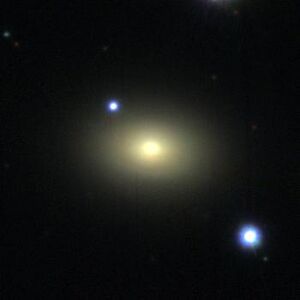NGC 712 facts for kids
NGC 712 is a fascinating galaxy located far, far away in space. It's a special type of galaxy called a lenticular galaxy, which means it looks a bit like a lens or a flattened disc. Imagine a mix between a spiral galaxy (like our own Milky Way) and an elliptical galaxy (which is more round or oval).
This galaxy can be found in the Andromeda constellation, which is a group of stars that form a pattern in our night sky. It's incredibly distant from us, about 244 million light-years away from our Milky Way galaxy. To give you an idea, a light-year is the distance light travels in one year – and light travels super fast! So, 244 million light-years is an almost unbelievable distance.
Contents
What is a Lenticular Galaxy?
A lenticular galaxy, like NGC 712, is a type of galaxy that has a bright central bulge, similar to a spiral galaxy. However, it doesn't have clear spiral arms like the Milky Way. Instead, it has a flat, disc-like shape, but with very little gas and dust left to form new stars.
- Shape: It looks like a lens or a flattened football.
- Star Formation: Most of the stars in a lenticular galaxy are older, as there isn't much new star formation happening.
- Location: They are often found in crowded areas of space, like galaxy clusters.
Where is NGC 712 Located?
NGC 712 is part of the Andromeda constellation. A constellation is basically a pattern of stars that people on Earth have imagined and named. The Andromeda constellation is famous for hosting the Andromeda Galaxy (M31), which is the closest large galaxy to our Milky Way.
- Constellation: Andromeda is one of the 88 official constellations.
- Visibility: You can see the Andromeda constellation in the northern sky during autumn and winter.
- Neighbor: While NGC 712 is in the same constellation, it's much further away than the famous Andromeda Galaxy.
How Far Away is NGC 712?
When we say NGC 712 is 244 million light-years away, it means the light we see from it today started its journey 244 million years ago! This is how astronomers measure vast distances in space.
- Light-year: This is a unit of distance, not time. It's how far light travels in one Earth year.
- Speed of Light: Light travels at about 300,000 kilometers (186,000 miles) per second.
- Past Views: When you look at NGC 712, you are essentially looking back in time to how it appeared 244 million years ago.
Discovery of NGC 712
NGC 712 was discovered by a famous astronomer named John Herschel in 1828. John Herschel was a British astronomer who made many important discoveries and observations of stars and galaxies.
- Discoverer: Sir John Herschel (1792–1871) was a pioneer in astronomy.
- Year: He first observed and recorded NGC 712 in the year 1828.
- Legacy: His work helped create detailed catalogs of celestial objects, which astronomers still use today.


